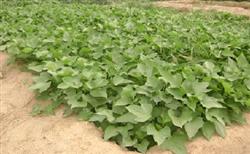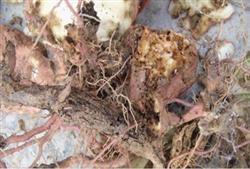How to manage Sweet Potato to achieve High yield

High-yield cultivation and management techniques of sweet potato: first, apply sufficient base fertilizer, reasonable soil preparation 1. Fertilization: as sweet potatoes are generally planted on thin sandy land, it is necessary to apply sufficient base fertilizer and improve soil fertility in order to obtain high yield. Generally speaking, about 5 mu of soil and miscellaneous dung, 25 kg of diammonium phosphate and 25 kg of potassium sulfate are appropriate. 2. Soil preparation: sweet potato is a root crop, which is suitable for growing in an environment with deep soil layer, loose soil and good ventilation. Deep ploughing can thicken the soil layer and improve soil ventilation, which is beneficial to the expansion of potato lumps. The depth of deep ploughing is generally 30 cm. Ridging cultivation is better for better soil fertility, but flat planting or low ridge cultivation is suitable for sandy land with thin soil fertility and high sediment content. Second, select superior varieties, timely early planting, reasonable close planting 1, seed selection: select high-quality and high-yield varieties. Such as virus-free Beijing 553, virus-free Xushu 18, Xinnong 1, Xinong 431, Yanshu 27, Sushu 8, Yushu 7 and other short vine high-yielding varieties. 2. Planting time: because there is a late frost before May 1 every year, it is appropriate to plant seedlings after May 1 in order to avoid frost damage. 3. Density: long vine varieties and fertile plots should be sparsely planted, while short vine varieties and thin land should be closely planted. Fertile land, long vine varieties 3000-3500 plants per mu, thin land, short vine varieties 4000 plants per mu, row spacing 60-70 cm, plant spacing 30 cm. 3. Field management 1. Planting seedlings: choose strong seedlings to be planted with horizontal shallow planting method, and the seedlings should be planted to the southeast and downwind to prevent the seedlings from being scratched by the wind. It is appropriate to bury the soil 1.5-2 inches deep and expose 3-4 leaves on the ground. Pour enough water when planting seedlings, and replenish the seedlings in time to ensure the whole seedling. 2. Early and middle ploughing, frequent weeding and Prophase management. Mid-tillage can loosen the soil, increase soil ventilation, increase soil temperature and eliminate weeds. Sweet potato is a drought-tolerant crop, so it should not be watered in the early stage, but it can be watered if the soil is too dry. The long vine variety picks the heart when the stem vine grows to about 1 foot, which promotes the stem vine to be thick and short and has many branches, which has a certain effect on increasing yield. 3. Mid-term vine control: July-August is the season of high temperature and rainy, with fast growth of stems and leaves, but slow expansion of potato tubers, which should be mainly controlled to prevent excessive growth of stems and leaves. The long vine varieties were sprayed with paclobutrazol for 2-3 times per mu, and the short vine varieties such as stem vine could also be sprayed appropriately. All the farmers who cultivate sweet potatoes in our land have the habit of turning vines after rain, but turning vines harms stems and leaves and reduces photosynthesis. Instead of increasing production, they should turn vines into lifting vines. Because of the time to lift the vine, after lifting the stem vine, still put back to the original place, do not make the stem and leaf damage, turn over, prevent the stem node from growing adventitious roots, control the stem and leaf growth, so as to achieve the purpose of increasing production. 4. Late management: after August, Rain Water is less, and drought often occurs, which affects the expansion of potato blocks. Watering can prevent premature senescence of stems and leaves and promote the expansion of potato lumps. For the land with yellow leaves and premature senescence of stems and leaves, 10 kg urea per mu can be applied to promote potato fertilizer, which has a certain effect on increasing yield. Spraying sweet potato bulge can increase the absorption of fertilizer, shorten the length of internodes, increase the thickness and chlorophyll content of leaves, induce the transfer of nutrients to potato lumps, and accelerate the expansion of sweet potato lumps. Spraying twice per mu with an interval of 15 days can increase the yield by more than 10%. Fourth, timely harvest: there is no certain harvest time for sweet potatoes, and farmers can harvest at the right time according to their own situation on the premise of maximum benefit. However, the collection will be completed by the end of October at the latest, so as not to be frozen and affect income.
- Prev

Sweet potato fertilizer 4 attention
Harvest at the right time to avoid mechanical damage. Summer potatoes should be harvested before and after frost, autumn potatoes should be harvested before the beginning of winter, sunny days should be selected for harvest, and wounds should be minimized or avoided when digging potatoes. Second, select healthy potatoes to ensure safe entry into the cellar. Before sweet potato enters cellar, want to be choosy, eliminate disease, remnant, rotten potato, moisture dries hind enter...
- Next

Two methods of killing underground pests of sweet potato
Sweet potatoes are damaged by underground pests, will be full of insects, can not be processed and eaten, and accelerate decay, resulting in a reduction in production. In production, the following methods can be taken in time for poisoning control in order to improve yield and quality. First, Benedict. During the growth and development of sweet potato, 1000 was sprayed on the leaves every 15 days.
Related
- Where is it suitable to grow horseradish in China? it is expected to see the middle altitude horseradish in Alishan.
- How to prevent tomato virus disease reasonably? (Control methods included)
- Many people like to plant towel gourd on the balcony. What are the main points of this method and management?
- What crops can chili peppers be mixed with?
- Fertilization techniques and matters needing attention in Tomato
- What are the grafting techniques for peach seedlings in spring?
- Harm and control methods of root swelling disease of Chinese cabbage
- What are the pests of sweet potatoes? How to prevent and cure it?
- Symptoms, causes and Control methods of navel Rot in Tomato
- The cause of "Cucumber rotten bibcock" in Farmers' planting Cucumber and its Control Plan

